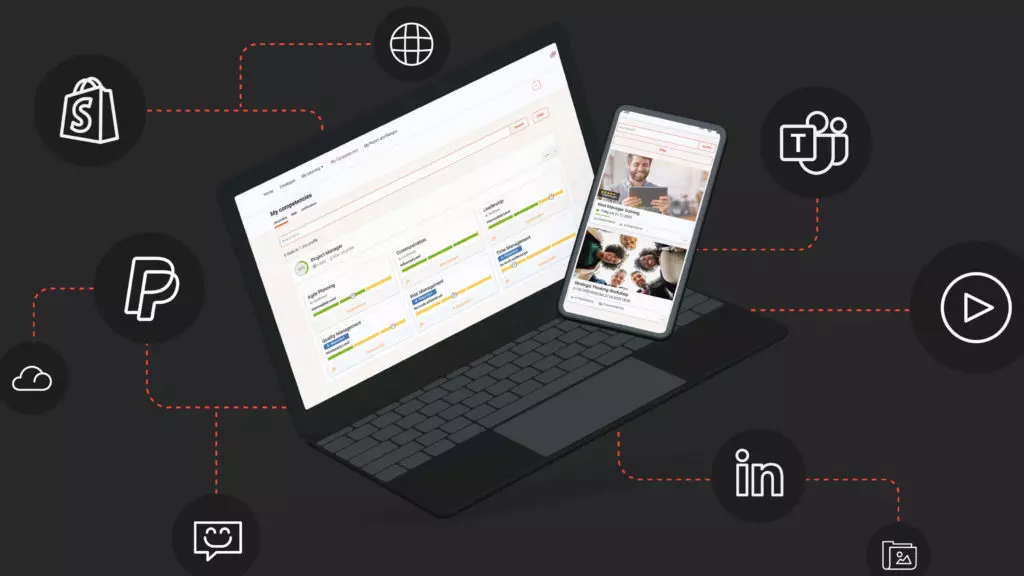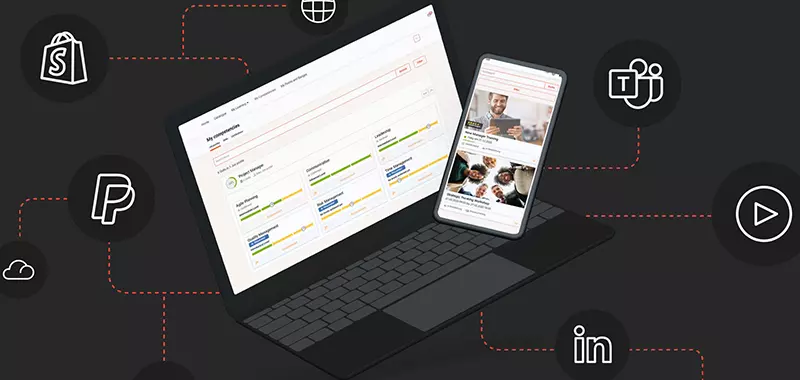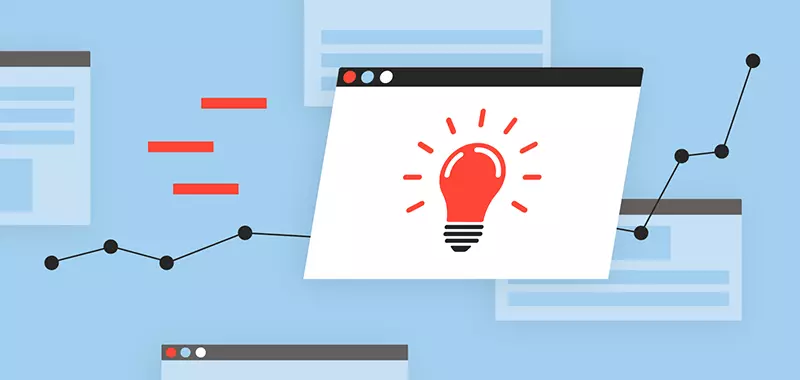LMS integration

LMS integration: definition, benefits, examples & security
Understanding the potential of integrating your learning management system (LMS) with other business software systems is essential. Effectively measure the impact of your learning and development programmes. In this article, we explore the key benefits this integration brings to both L&D and the wider organisation. We’ll also provide common examples of LMS integrations and share best practices for implementing them securely and seamlessly.
Ready to switch to a new enterprise LMS?
Upgrading your LMS is a strategic move towards a more agile, scalable, and future-proof learning environment. Download the LMS Upgrade Guide now to take the first step towards enhancing your organisation's learning and development capabilities.
What is LMS Integration?
LMS integration is the ability of your learning management system to receive and share data with existing software across your tech stack. It allows for the automation of many repetitive tasks. It also enables you to combine useful data from other software with that of your training and vice-versa.
Benefits of LMS Integration
Your learning management system (LMS) can greatly increase the reach, speed and effectiveness of your training program. However, how effective your new LMS is in driving improvements in business performance depends greatly on how well it fits in with your existing technologies.
The benefits of LMS integration include:
Little to no admin duplication across systems
With a secure connector in place, integration with existing software means that your new LMS can be fully populated with all your learner details. And that, in minutes - not hours, days or weeks.
Faster time to competency with a new learning platform
When your LMS is integrated with your other systems, shared data is available and easy to find. Your users can spend more time exploring features relevant to their needs.
Greater user adoption
When your LMS is already ready to go with information on learners and their performance from other systems, friction is reduced. Users can see relevance and value in the platform straight away. Reducing friction makes your users see a new LMS as something that will make their lives easier, rather than adding to their workload.
Improved Compliance
When integrated with your legal and/or HR systems, the LMS can receive alerts when new legislation requires certain training for a group of learners. Likewise, you can send alerts for refresher training and re-certification.
Enhanced data capture and learner analytics
L&D teams can link performance data from other software to learning pathways relevant to individuals and groups. For example, sales performance data from a CRM like Salesforce could trigger training suggestions in the LMS.
Better training evaluation
Monitor training to help evaluate its effectiveness. Show training ROI and any need for content improvement or interventions to support individuals.
LMS integration with popular business software products makes L&D easier out of the box, rather than at a distant point in the future.
Common Integration Examples
A large organisation will find LMS integration with a wide array of commercial software a huge time saver, and uncover a great deal of useful data. Here are just a few common examples of powerful integrations (find more about integrations on our LMS page):
Microsoft Teams
By integrating with collaboration software like Microsoft Teams, you can pull useful documents and other assets into your LMS to use as materials for training and knowledge sharing. You can also set up individual or group training sessions and peer to peer support via video conferencing. Data on all of this can be captured and analysed within the LMS.
YouTube or LinkedIn Learning
As well as creating eLearning content to be housed within your LMS, content curation is an increasingly popular way of accessing the latest and best learning materials from multiple sources. Courses and tutorials from the likes of LinkedIn Learning and YouTube can be pulled into and organised within the LMS, with learner interaction measured.
PayPal or Shopify
Training doesn’t need to be just a cost - with PayPal or Shopify ecommerce integration, you can sell learning materials and courses through your LMS, creating new revenue streams for your business.
Salesforce CRM
Organise training for sales and account managers, and for external partners - and even customers - based on their profile within a CRM like Salesforce.
Workday or SAP
Your Human Capital Management software will likely contain profiles of your entire workforce. By integrating your LMS with HCM like Workday and SAP SuccessFactors, your learning platform can be immediately populated with employee data, with training organised by role, location and more.
How to Integrate Securely
When integrating software systems - especially those accessed online - tight data security is an essential consideration. Hacking two systems together off the cuff is not the way to go, however smart your IT team is. Tried and tested connectors are important to ensure security and future-proofing of your solutions no matter who is managing your IT.
Authentication should happen via an established identity provider - be it SAML 2.0, Open ID or OAuth. Single Sign On (SSO) means that users will be able to access multiple systems, including your LMS with one username and password.
This allows stronger logins to be used (as employees need not make them overly simple in order to remember many), and when a password needs to be changed, it can be done so for all your systems with a single update.
So, above is an overview of LMS integrations, with a definition, the benefits and how to do them well. By making your entire software stack an integrated ecosystem, the LMS can play a central role in driving organisational efficiencies and business improvement. If you want to know more about LMS integrations and connectors, don't forget to visit the integrations and connectors page of the imc Learning Suite.
If you want to know more about our integrated LMS solution (imc Learning Suite), find more information here or feel free to get in touch with us.

Find out imc Learning Suite Integration Features
With various add-ons and countless connectors, imc Learning Suite is one of the most customisable learning management systems on the market.

Get to know more about imc Learning Suite product updates
Our teams in product management and development are continuously working on improving imc Learning Suite to provide the best possible user experience for admins, tutors and learners.